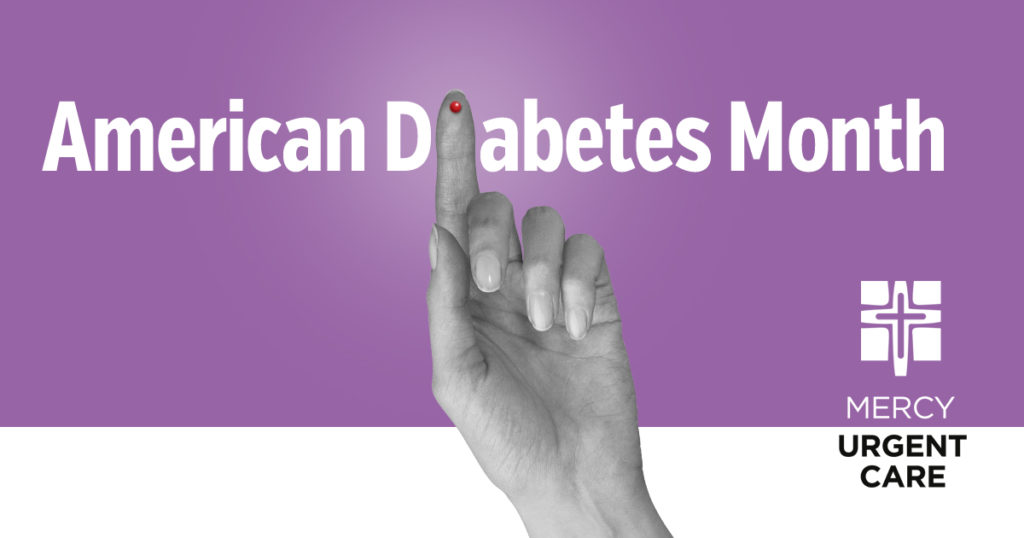 Diabetes is one of the leading causes of death and disability in the United States — affecting one in every 10 Americans. As November, American Diabetes Month, winds down, Mercy Urgent Care stresses the importance of diabetes awareness and advocates for those living in its grasp.
Diabetes is one of the leading causes of death and disability in the United States — affecting one in every 10 Americans. As November, American Diabetes Month, winds down, Mercy Urgent Care stresses the importance of diabetes awareness and advocates for those living in its grasp.
More than 30 million people in the United States have diabetes — and another 84 million adults are at risk. Though a small percentage of people develop the incurable Type 1 diabetes, most individuals are diagnosed with Type 2, which can often be treated and managed through diet, exercise and medication.
If not controlled, diabetes can cause blindness, nerve damage, kidney disease and other problems — and, for those living with the disease, diabetes can affect nearly every decision in their daily lives.
So, who is at risk of developing diabetes? You may be at risk if:
- You are overweight or obese. Being overweight or obese is the main risk factor for developing type 2 diabetes, as fatty tissue causes cells to become resistant to insulin.
- Your body primarily stores fat around the abdomen. If you’ve ever noticed that you gain weight primarily (or disproportionately) in your belly — rather than around your hips and thighs — you may have an increased risk for developing type 2 diabetes.
- You are physically inactive for long periods of time. Individuals who are physically active less than three times per week are at a heightened risk of developing type 2 diabetes.
- You have a family history of type 2 diabetes. If a close relative, such as a parent or sibling, had or has type 2 diabetes, you are at an increased risk of developing the disease.
- You are African American, Latino, Native American, Asian American, an Alaskan native or Pacific Islander. Some races are more likely to develop type 2 diabetes, and it’s uncertain why.
- You’re age 45 or older. As with many health conditions, your risk rises as you grow older. But it’s important to note: Type 2 diabetes can occur at any age.
- You’ve been diagnosed with prediabetes. Your blood sugar levels have already tested higher than normal, and, without proper treatment and monitoring, prediabetes can progress to type 2 diabetes.
- You’ve ever had gestational diabetes. During pregnancy, some women temporarily develop diabetes in the form of gestational diabetes. If you’ve experienced this or have given birth to a baby that weighed more than 9 pounds, you are also at a higher risk.
- You are a woman with polycystic ovarian syndrome. This hormonal disorder, often shortened to PCOS, puts women at a higher risk of developing type 2 diabetes.
Common early symptoms of type 2 diabetes include frequent urination, unquenchable thirst, insatiable hunger (even when you are currently eating), extreme fatigue, blurry vision, slow-healing cuts and bruises and tingling, pain or numbness in the hands or feet. (Type 1 diabetes may cause a person to lose weight, despite ingesting more calories than before.)
The good news, though, is that you can lower your risk of developing type 2 diabetes with a few lifestyle changes: eating healthy food, exercising and losing weight. To some, healthy eating and exercise may seem daunting — but the first step to developing healthier habits is to simply begin.
Make small changes at first — opt for the stairs instead of the elevator — and graduate to larger changes, like making healthy choices in your everyday diet. Aim for 30 minutes of moderate physical activity per day, and regularly check (and manage) your blood pressure. If you are overweight, reducing your body’s weight by 7 percent can reduce your risk of developing type 2 diabetes.
If you suspect you may be living with undiagnosed diabetes, make an appointment with your healthcare provider today. This November — and all year long — Mercy Urgent Care wants you to be more aware of the risk factors, symptoms and treatments for type 2 diabetes. And, as always, we’re here for you.

